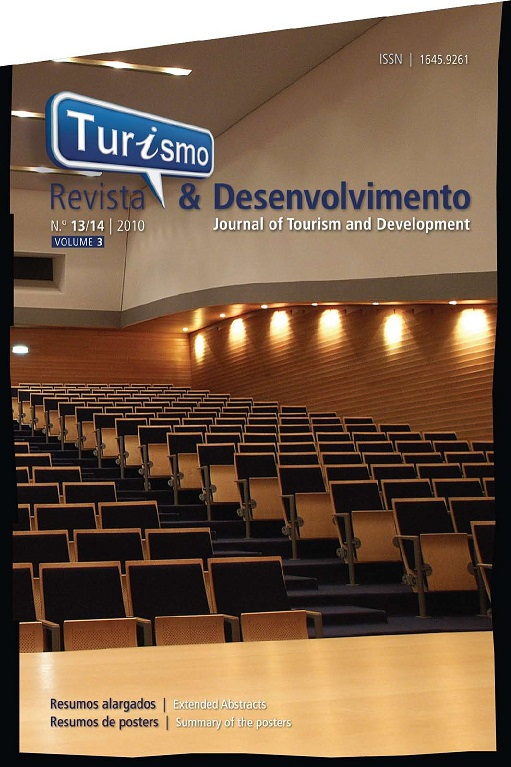How museum perceptions influence cultural tourism practices
Resumo
Objectives | The main objective of this research was to explore people’s perceptions regarding art museums and construct a conceptual model which would be sensitive to both sociological and psychological factors that influence museum visitation. Sixty individuals were interviewed for this reason. One of the recurrent themes that appeared throughout the interviews was the experience of travelling and visiting museums abroad. Thus, cultural tourism narratives emerged without explicitly asking for them. The narratives of five interviewees (the most representative cases) are presented in order to demonstrate how narrativebased research methodology can reveal subtle perceptual differences between research participants. In addition, the resulting conceptual model will be offered as an alternative to traditional cultural tourism typologies.
Methodology | Sixty semi-structured, in-depth interviews were contacted in Nicosia, Cyprus in two phases. The first phase included interviews with 30 individuals, transcriptions of the interviews as well as their partial analysis. During the second phase, the interview protocols were revised by adding some questions that further explored emerging key issues and 30 additional individuals were interviewed.The division of the interview process into two phases helped the researcher reflect on where the research was going, re-evaluate the needs of the study and make the appropriate methodological decisions. To complement the data gained from the interviews, two other research methods were used. First, the interviewees were asked to complete a short questionnaire at the beginning of each interview. The use of a questionnaire generated valuable demographic information as well as information about the travelling frequency of each interviewee. Second, during the interview, participants were provided with a blank piece of paper with the words ‘art museum/ art exhibition’ in the centre and were asked to take a few moments to write or draw whatever came to their minds when they thought of art museums. Then, the resulting map was discussed. The main advantage of the ‘personal meaning map’ method is that it offered participants some time to reflect on their feelings and thoughts through free association, and thus elicited deeper responses. The mean interview time was 38 minutes. Multiple research sites and recruitment methods were used in order to achieve a theoretical sampling. One art museum (The Byzantine Museum and Art Galleries) and one art gallery (The ARTos Foundation) served as recruitment sites for visitors. However, most participants (non-visitors and visitors) were recruited from four different cafes in the centre of Nicosia. Furthermore, some participants were asked to recommend friends, relatives or neighbours who would be willing to be interviewed. This recruiting technique is called ‘snowballing’ and is ideal for recruiting ‘hidden populations’, in this case, individuals who were not possible to recruit through museums or cafes such as older non-visitors or busy parents with children. Interviewees were grouped according to their visitation frequency into (a) very frequent, (b) frequent, (c) regular, (d) occasional, (e) rare and (f) non-visitors. The data were stored, coded, and analyzed with the help of N5 (NUD*IST 5, QSR International), a qualitative research software program,chosen because of its ability to work with complex qualitative data and to assist deep levels of analysis.
Main results and contributions | Museum visitor literature has not paid much attention to how people view museums when they travel. Furthermore,most research about cultural tourism comes from the tourist industry and explores the subject from the point of view of the destination – that is, it examines the amount of cultural tourism in a country or the benefits of cultural tourism. The research methodology of this study employed narrative-based techniques which are sensitive to how people perceive and engage with cultural sites. Participants were interviewed in their home country so the narratives are interwoven with memories and general perceptions about museums and not with specific destinations or cultural institutions. The conceptual model of this study is presented as an alternative to traditional strict cultural tourist classifications. Eight different “museum perceptual filters” which influence the way people perceive museums were identified. These are the: (a) professional, (b) art loving, (c) self-exploration, (d) cultural tourism, (e) social visitation, (f) romantic, (g) rejection and the (h) indifference filter. Recent tourism literature recognizes that cultural tourists are not a homogenous mass but a heterogeneous market with different characteristics and needs.As a result, a number of researchers have offered typologies of cultural tourists.With the help of five case-studies I will attempt to demonstrate how the museum perceptual filter model can contribute to the debate of cultural tourism typology and show why those typologies might be too broad.
Limitations | The fact that participants base their narratives on memories can also be a disadvantage. We do not actually know in reality how participants behave when abroad – we only know how people see themselves behaving. Also, the research methodology described can not provide researchers with practical information about specific sites and destinations. Furthermore, even though the methodology used is appropriate for the construction of a conceptual model, it is not appropriate for making certain generalizations. As a matter of fact, the research sample is too small and not representative of the Cyprus population. Therefore, no statistical generalizations can be made.
Conclusions | People might instantly become cultural tourists as soon as they visit an art museum when travelling, but their museum perceptions do not change.What determines the way people use museums in their tourist destination is not their location in the world, but what perceptual filters they own and therefore can use.Alternative research methodologies, which highlight issues of identity and perception while examining cultural tourism practices as part of everyday life, can elicit deeper responses and thus have greater explanatory power.





